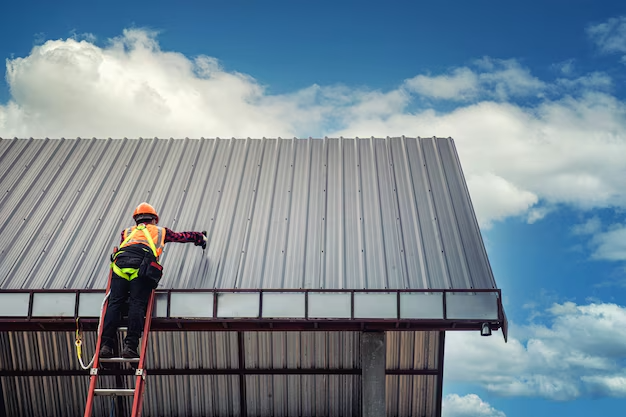A new roof installation begins with the careful removal of your old roof, followed by a thorough inspection and preparation of the roof deck. Next, a protective underlayment is applied, and then high-quality roofing materials are installed. Flashing is placed around key areas such as chimneys and vents to ensure maximum protection against leaks. Depending on the size and complexity of the roof, this process typically takes between 1 to 3 days to complete.
New Roof Installation

Why Is a Proper Roof Installation Necessary?
1. Enhances Durability
A properly installed roof is built to last. Professionals ensure the materials are securely fastened and that all components, like underlayment and flashing, are installed correctly. This helps the roof withstand extreme weather conditions, such as heavy rain, snow, or high winds. A poorly installed roof, on the other hand, is prone to issues like leaks and material failure.
2. Improves Energy Efficiency
A good roof installation includes proper insulation and ventilation, which regulate indoor temperatures. This not only keeps your home comfortable throughout the year but also lowers energy bills. Poor installation can lead to air leaks, drafts, and higher HVAC costs, making energy efficiency a challenge.
3. Boosts Safety
Safety is a critical reason to invest in proper installation. Errors during the process can lead to leaks, structural weaknesses, or even roof collapse in extreme cases. By ensuring every layer is properly installed and reinforced, you minimize risks and create a safer environment for your family.
4. Saves Money Long-Term
While professional installation might cost more upfront, it pays off in the long term. A quality roof reduces the need for frequent repairs and minimizes the chances of costly secondary damage, such as water intrusion that ruins insulation or walls. Additionally, correctly installed roofs often come with warranties, giving you peace of mind.
Roof Installation Process
Initial Consultation
The process starts with an initial consultation where you discuss your goals, budget, and any specific requirements with a roofing contractor. This is the ideal time to share any concerns or preferences about materials, design, or warranties. A thorough consultation ensures the project is customized to fit your home’s needs. This step lays the groundwork for success by aligning expectations between you and the contractor. By preparing questions and researching your options in advance, you’ll make this phase more productive and smooth.
Roof Inspection
A professional inspection is conducted to assess the current roof’s condition and to take accurate measurements. Contractors look for underlying issues such as leaks, rotting wood, or structural weaknesses that need to be addressed before installation begins. This step ensures there are no surprises during the project. Detailed measurements also help avoid material shortages or unnecessary waste, keeping the project efficient. Homeowners can prepare by pointing out existing concerns, such as sagging areas or water damage, to assist the contractor.
Choosing Materials
Once the inspection is complete, you’ll work with the contractor to choose the best roofing materials and design for your home. Options include shingles, metal, tiles, and more based on your preferences and local weather conditions. Durability, aesthetics, and budget are important considerations during this phase. Selecting high-quality materials ensures long-term performance and adds curb appeal to your property. Contractors can provide recommendations, but it’s always helpful to research your choices to find the best fit for your needs.
Preparing the Site
Before any installation work begins, the site needs proper preparation. The crew will set up protective barriers, such as tarps or plywood, to shield landscaping, driveways, and outdoor furniture from debris. They’ll also ensure all equipment is in place for safe and efficient work. By taking precautions, contractors minimize potential damage to your property during the roofing process. Homeowners can assist by clearing the area around the house of vehicles, garden ornaments, or other items that could obstruct access.
Removing the Old Roof
The existing roof materials, such as shingles, underlayment, and flashing, are carefully removed to expose the roof deck. This step is noisy and creates debris, but it’s critical for identifying damage hidden beneath the surface. Contractors ensure all waste is safely handled and removed from the site. Proper removal prevents compatibility issues with the new materials and supports structural integrity. Communicating this stage to your neighbors in advance is a good way to maintain friendly relations during the project.
Deck Inspection
Once the old roof is stripped away, the roof deck is thoroughly inspected for rot, water damage, or weak spots. Any necessary repairs or reinforcements are made to restore its strength. This ensures the deck can properly support the layers of materials that will be installed on top. Skipping this step risks compromising the durability of the new roof. Homeowners should prepare for potential surprises by allowing some flexibility in the project timeline and budget for unexpected repairs.
Adding Underlayment
The underlayment, a water-resistant barrier, is installed over the roof deck to protect it from moisture and potential leaks. This step is critical for ensuring the longevity of the roofing system. It acts as a second line of defense against weather, especially in areas prone to heavy rain or snow. High-quality underlayment also improves the roof’s overall durability. To optimize protection, contractors choose underlayment that matches the roofing materials and the climate of the region.
Installing New Materials
The selected roofing materials, such as shingles, metal panels, or tiles, are securely installed over the underlayment. This phase requires precision and attention to detail to ensure all components fit correctly and align properly. The new materials serve as the main shield against weather elements, so the installation must be thorough. Proper techniques ensure the roof will adhere to manufacturer warranties and last its full lifespan. Regular communication with the contractor during this stage can keep homeowners informed on progress.
Flashing Installation
Flashing, typically made of metal, is applied around vulnerable areas like chimneys, vents, and valleys to prevent water infiltration. This step is crucial for protecting these spots, which are prone to leaks. Properly installed flashing seals gaps and aids in directing water away from the roof. Professional installation ensures these areas remain watertight and resistant to damage over time. Homeowners can verify with the contractor that all critical areas are adequately sealed as part of the finished work.
Final Inspection
After installation, a thorough inspection is completed to ensure all elements of the roof meet quality standards and local building codes. Your contractor will review the finished roof with you, addressing any last-minute concerns and providing maintenance tips. This final walkthrough confirms the roof’s readiness to provide long-term protection. Additionally, warranties for materials and labor may be discussed at this stage. Being present during the final inspection allows homeowners to confirm all expectations have been met.
What Materials Are Commonly Used for Roof Installation?
Choosing the right material for your roof is essential for balancing durability, cost, and aesthetics. Here are some of the most commonly used materials for roof installation and their benefits:
1. Asphalt Shingles
Affordable and widely popular, asphalt shingles are the go-to choice for many homeowners. Their durability, ease of installation, and variety of colors make them a versatile option. Ideal for most climates, they can last 20-30 years with proper maintenance.
2. Metal Roofing
Metal roofs, available in materials like aluminum and steel, are known for their longevity and resistance to extreme weather. They’re lightweight, energy-efficient, and recyclable, making them perfect for eco-conscious homeowners. Metal roofs can last 50+ years, though they come at a higher initial cost.
3. Clay Tiles
These classic, durable tiles are especially suited for hot, dry climates. They provide natural insulation and boast a unique aesthetic, often seen on Mediterranean or Spanish-style homes. While durable, their weight requires strong structural support.
4. Wood Shakes
For a rustic look, wood shakes or shingles are a great option. They offer beautiful aesthetics and good insulation properties but require regular maintenance to resist moisture and insects. Best for moderate climates, they can last 30-40 years.
5. Slate
Slate roofs are known for elegance and exceptional durability, lasting over a century in some cases. Fire-resistant and ideal for colder climates, they represent a significant upfront investment but require minimal maintenance.
Each material has unique advantages, and selecting the right one depends on your budget, style preference, and local climate conditions.
Why Choose Us for Your New Roof Installation?
At Reliable Roofer Liverpool, we pride ourselves on delivering top-notch roof installation services that combine affordability, durability, and style. Our team of experts ensures that every new roof installation is tailored to meet your needs, providing you with peace of mind and optimal value. Whether you’re looking to enhance your home’s safety or boost its aesthetics, we’re here to help every step of the way. Get in touch today to schedule your consultation and receive a tailored quote!
FAQs
What Are The Steps Of Installing A New Roof?
The process typically involves removing the old roof, inspecting and repairing the roof structure, installing underlayment, laying new shingles or tiles, adding flashing around features like chimneys, and cleaning up the site.
Can I Get A Government Grant For A New Roof In The Uk?
There is no specific government grant for roof replacements, but certain homeowners, such as those on low income or with specific health conditions, may be eligible for help under schemes like the Energy Company Obligation (ECO).
What Time Of Year Is The Cheapest To Replace A Roof?
Late autumn and winter are typically the cheapest times to replace a roof due to lower demand. However, weather conditions can impact work schedules and pricing.
What Is Included In A Roof Replacement In The Uk?
A roof replacement in the UK includes removal of the old roof, repairs to the structure if necessary, installing new materials (such as tiles or slate), adding underlayment, flashing, and ensuring proper ventilation.
Does A New Roof Need Ventilation?
Yes, a new roof should have proper ventilation to prevent moisture buildup, which can cause damage to roofing materials and lead to issues like mold or rot. Ventilation helps regulate temperature and moisture levels.
Get Free Consultation
Others Services
Ready to get started?
If you are in Liverpool and require expert roofing services, don’t hesitate to get in touch with us. We are eager to work with you and provide the roofing solutions you need. Call us today at 07742076612 to schedule a consultation or request a quote. Let us help you keep your home safe and secure with our reliable roofing services.

